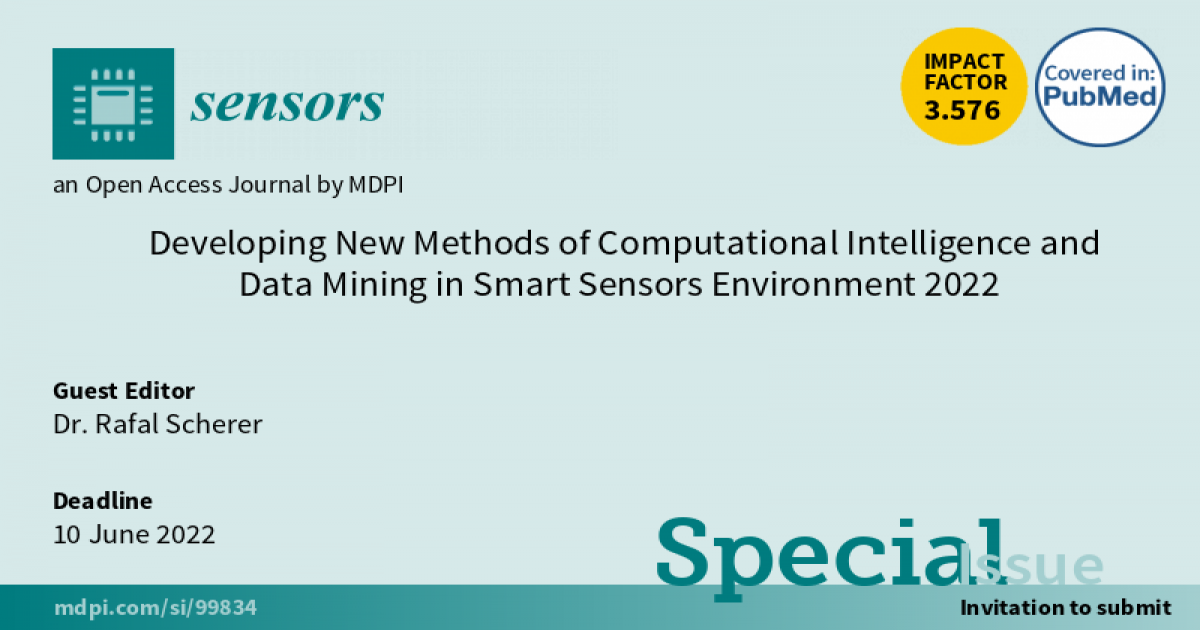Developing New Methods of Computational Intelligence and Data Mining in Smart Sensors Environment 2022
A special issue of Sensors (ISSN 1424-8220). This special issue belongs to the section "Intelligent Sensors".
Deadline for manuscript submissions: closed (10 January 2023) | Viewed by 13510

Special Issue Editor
Interests: neural networks; computer vision; cybersecurity
Special Issues, Collections and Topics in MDPI journals
Special Issue Information
Dear Colleagues,
Machine learning and computational intelligence methods, especially deep learning, can be used to create smart sensors that can perform testing, classification, or prediction. The whole menagerie of sensors, including inductive proximity sensors, photoelectric retroreflective sensors, ultrasonic sensors, and others, can be beneficial to all areas—from Industry 4.0 through cars to smart offices, homes, or hospitals. Synergistic hyperconnectivity brought by the emergence of the IoT will increase the applicability of such intelligent sensors. This Special Issue is addressed to all soft computing methods enabling in-sensor, edge, and similar computing for machine vision, data acquisition, or diagnostics. The methods covered will include deep learning, fuzzy logic, evolutionary methods, and various data mining techniques.
Dr. Rafal Scherer
Guest Editor
Manuscript Submission Information
Manuscripts should be submitted online at www.mdpi.com by registering and logging in to this website. Once you are registered, click here to go to the submission form. Manuscripts can be submitted until the deadline. All submissions that pass pre-check are peer-reviewed. Accepted papers will be published continuously in the journal (as soon as accepted) and will be listed together on the special issue website. Research articles, review articles as well as short communications are invited. For planned papers, a title and short abstract (about 100 words) can be sent to the Editorial Office for announcement on this website.
Submitted manuscripts should not have been published previously, nor be under consideration for publication elsewhere (except conference proceedings papers). All manuscripts are thoroughly refereed through a single-blind peer-review process. A guide for authors and other relevant information for submission of manuscripts is available on the Instructions for Authors page. Sensors is an international peer-reviewed open access semimonthly journal published by MDPI.
Please visit the Instructions for Authors page before submitting a manuscript. The Article Processing Charge (APC) for publication in this open access journal is 2600 CHF (Swiss Francs). Submitted papers should be well formatted and use good English. Authors may use MDPI's English editing service prior to publication or during author revisions.
Keywords
- sensor networks
- smart/intelligent sensors
- sensor devices
- sensor technology and application
- sensing principles
- Internet of Things
- fuzzy logic
- data mining
- data fusion and deep learning in sensor systems
Benefits of Publishing in a Special Issue
- Ease of navigation: Grouping papers by topic helps scholars navigate broad scope journals more efficiently.
- Greater discoverability: Special Issues support the reach and impact of scientific research. Articles in Special Issues are more discoverable and cited more frequently.
- Expansion of research network: Special Issues facilitate connections among authors, fostering scientific collaborations.
- External promotion: Articles in Special Issues are often promoted through the journal's social media, increasing their visibility.
- e-Book format: Special Issues with more than 10 articles can be published as dedicated e-books, ensuring wide and rapid dissemination.
Further information on MDPI's Special Issue polices can be found here.






